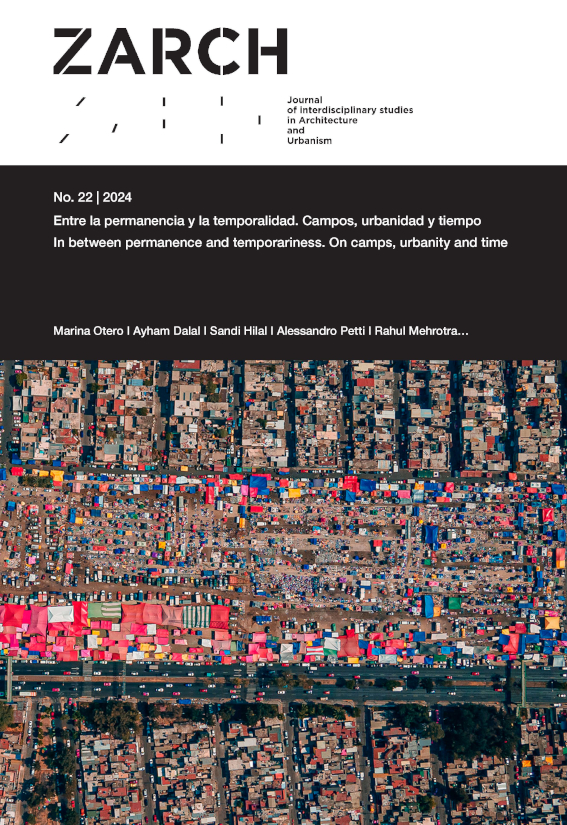Sistemas enredados. El Método Leoz frente a la técnica constructiva
DOI:
https://doi.org/10.26754/ojs_zarch/zarch.2024229897Palabras clave:
Método Leoz, Arte concreto, Industrialización, Hiperpoliedro, BrasiliaResumen
Rafael Leoz fue un arquitecto enigmático entre los de su generación porque investigó en algo diferente a los demás: un método para proyectar la arquitectura del futuro; y el hecho de haber llegado a construir algunos edificios con ese ‘método’ revela la importancia de su aportación. Tras su participación en la VI Bienal de Sao Paulo de 1961, compuso una atractiva narración que, recogida en numerosas publicaciones, le ha situado al borde de la mitificación. Las investigaciones sobre su trabajo se han centrado principalmente en el ‘módulo Hele’ y en su implicación sobre la industrialización de la vivienda social y esta circunstancia es la principal razón por la que no se haya profundizado en las implicaciones de su método, recogido en el libro Redes y Ritmos Espaciales.
En sus escasos quince años de vida profesional, Leoz estableció unas relaciones muy fructíferas con artistas, pensadores y políticos, pero fue su conexión con el arte concreto y su colaboración con el CCUM (Centro de Cálculo de la Universidad de Madrid) lo que fortaleció la investigación sobre su método. Ya en los 70, la incorporación de las nuevas dimensiones geométricas de los hiper-poliedros, cuyos principios fueron esbozados en un inconcluso libro, verificó la validez del ‘Método Leoz’ con la construcción de la Embajada de España en Brasilia. El Método Leoz, aplicable tanto a la docencia como al proyecto de la arquitectura, muestra una manera de hacer que, fundamentada en su esencia modular, permite entender la creación de espacios como el resultado de una constante transformación combinatoria desplegada en el tiempo.
Descargas
Referencias
Agrasar-Queroga, Fernando. “La arquitectura de la Embajada”. Rafael Leoz, arquitecto de la Embajada de España en Brasil. Brasilia: Consejería Cultural de la Embajada de España en Brasil, Ed. Briquet de Lemos, 2012.
Álvarez, Raquel; Galván, Noelia; Martínez, José Manuel. "Maquetas y vivienda modular: la experiencia del taller de arquitectura de Ricardo Bofill." DOI: 10.4995/EGA.2021.14537.
Archer, L. Bruce, "Systematic method for designers." Design 172 (April 1963)
Mandelbrot, Benoît, Los objetos fractales: Forma, azar y dimensión. Barcelona: Editorial Tusquets, 1996.
Cervero, Noelia. "Rafael Leoz y la abstracción geométrica en los años sesenta" DOI:10.4995/EGA.2020.12650.
Ghyka, Matila. Estética de las Proporciones en la Naturaleza y en las artes. Barcelona: Editorial Poseidón, 1977.
Fundación Rafael Leoz, "Monografía sobre la Fundación Leoz" Revista BODEN nº17, Spring 1978.
Gómez de las Heras, María Elisa, "Rafael Leoz y la integración de las artes en una arquitectura social" Revista Cuadernos hispanoamericanos, no. 341 (1978): 335-360.
Jones, John Christopher; Thornley, D.G. A Method of Systematic Design. Oxford: Pergamon Press, 1963.
Le Corbusier, Le Modulor. Buenos Aires: Editorial Poseidón, 1953.
Leoz, Rafael, Redes y Ritmos Espaciales. Fundación Rafael Leoz para la Investigación y Promoción de la Arquitectura Social, 1969. Madrid-Barcelona. Editorial Blume, 1979.
Lima, Angélica; Victal, Jane, "Rafael Leoz y los diálogos transnacionales propiciados por las Bienales de Sao Paulo" Bitácora Arquitectura, no. 47 (2021).
López, Jesús, "Pensamiento, filosofía y principios arquitectónicos en la obra de Rafael Leoz: el espacio como materia prima." Pioneros de la arquitectura moderna española: Vigencia de su pensamiento y obra, 70-93. Madrid: Fundación Alejandro de la Sota, 2015.
López, Jesús; Ruiz, J. Antonio, "Los dibujos de Rafael Leoz sobre vivienda social" UNED, 2021.
Moya, Luis, "Rafael Leoz" Ministerio de Educación y Ciencia, no. 151 (1978): Madrid.
Varios autores, "Rafael Leoz, arquitecto de la embajada de España en Brasil" Rafael Leoz, arquitecto de la Embajada de España en Brasil, Consejería Cultural de la Embajada de España en Brasil with Ed. Briquet de Lemos, Brasilia, 2012.





